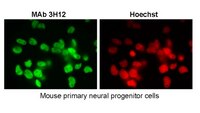MABS1139 Sigma-AldrichAnti-SUMO2/3 Antibody, clone 3H12
Detect SUMO2/3 and SUMO2/3-modified (SUMOylated) proteins using this rat monoclonal Anti-SUMO2/3 Antibody, clone 3H12, Cat. No. MABS1139, validated for use in Immunocytochemistry and Western blotting.
More>> Detect SUMO2/3 and SUMO2/3-modified (SUMOylated) proteins using this rat monoclonal Anti-SUMO2/3 Antibody, clone 3H12, Cat. No. MABS1139, validated for use in Immunocytochemistry and Western blotting. Less<<Recommended Products
Overview
| Replacement Information |
|---|
Key Specifications Table
| Species Reactivity | Key Applications | Host | Format | Antibody Type |
|---|---|---|---|---|
| R, H, M | WB, ICC | R | Unpurified | Monoclonal Antibody |
| References |
|---|
| Product Information | |
|---|---|
| Format | Unpurified |
| Presentation | Rat IgG2a hybridoma culture supernatant with 0.05% sodium azide. |
| Quality Level | MQ100 |
| Physicochemical Information |
|---|
| Dimensions |
|---|
| Materials Information |
|---|
| Toxicological Information |
|---|
| Safety Information according to GHS |
|---|
| Safety Information |
|---|
| Packaging Information | |
|---|---|
| Material Size | 100 µL |
| Transport Information |
|---|
| Supplemental Information |
|---|
| Specifications |
|---|
| Global Trade Item Number | |
|---|---|
| Catalog Number | GTIN |
| MABS1139 | 04054839132704 |
Documentation
Anti-SUMO2/3 Antibody, clone 3H12 SDS
| Title |
|---|
Anti-SUMO2/3 Antibody, clone 3H12 Certificates of Analysis
| Title | Lot Number |
|---|---|
| Anti-SUMO2/3, clone 3H12 -Q2795447 | Q2795447 |










